Freedcamp is a popular project management tool known for its affordability and versatility. It offers features like task management, issue tracker, and discussion board, making it a solid choice for a small organization. However, as your team grows or projects become more complex, you may start noticing Freedcamp’s limitations, such as basic project management capabilities, limited collaboration features, and a steeper learning curve.
I have tested and used the platform and found that those limitations can be concerning for the organization. Thus, you need a Freedcamp alternative that not only provides the basic features but also scales, offers richer collaboration, and makes daily work easier instead of harder.
I have researched and compiled this list of 7 top Freedcamp alternatives for 2026. This list is based on my use of the tool, real-world insights, and customer reviews.
Why look for Freedcamp alternatives?
Despite all its capabilities and features, there are many areas where Freedcamp lacks. Here are some of the main limitations of Freedcamp that drive users to look for alternatives.
1. Not ideal for growing teams
Freedcamp offers a robust free plan with extensive features for basic task management. However, advanced features like Gantt charts, custom fields, table views, reports, and analytics are reserved for the top-tier. Thus, it can quickly drive up costs and make it less budget-friendly compared to flat-rate alternatives.
2. Lack of user-friendly UI
Freedcamp’s interface looks simple for a small number of projects, collaborators, and features. However, when you increase projects, features, and users, it becomes overwhelming and cluttered. Navigation can be time-consuming, especially with multiple projects or complex boards, making it difficult to use.
Michael on Software Advice shares his experience: “ We found the UI to be a little overcomplicated by offering too many options. Every screen is almost riddled with toggles, options, settings, and information. Some of our less tech-savvy members took a long time to get used to all the different screens and features.”
3. Steeper learning curve
Not all users find Freedcamp easy to work with. Some feel the interface is cluttered and harder to navigate, especially for new or non-technical team members. With the increased features in top-tier paid plans, it has a steeper learning curve compared to other project management tools.
A user stated on Capterra, a review site,” It was a little cumbersome to get started on your own. It would be great to have had a ‘getting started’ session or conversation with a sales rep to get some guidance on how to use the software most effectively for our particular needs.
4. Limited reporting options
Analytics and insights are minimal, making it harder to track progress at scale. You cannot generate a report for specific metrics, like time spent, category, and team members’ names. If you want a few more features in the reports, then it’s only available in the Business and Enterprise plans.
Bamidele J. on G2 wrote “The reporting features are not upto the mark, thereby making the project report more difficult.”
5. No instant messaging feature like chat
You can not just hover over someone’s name and start sending messages. In fact, when communicating with someone, you need to create a conversation room and then add the user you want to talk to. Moreover, only the administrator can manage the conversation, which includes adding or removing users, archiving the conversation, or deleting it.
That’s a little complex than the competitors that offer instant messaging features.
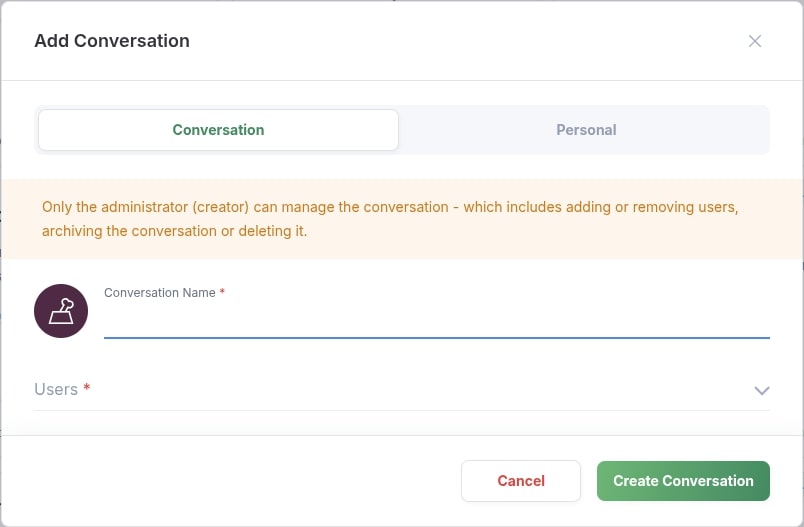
6. Lacks proofing features
If your work involves reviewing large volumes of images, texts, or other creative assets, Freedcamp might not be the best choice. Users can leave notes or comments on files, which helps track file changes, but it is not a formal review/approval workflow.
For file proofing (such as annotating documents, requesting graphic approvals, or structured approval status), Freedcamp relies on manual comments or third-party integrations, rather than specialized review features.
7. Limited integrations
It offers basic integration with tools like Google Drive, Dropbox, OneDrive, etc., but still, it is less compared to other tools. Teams that have complex workflows and use tools like Salesforce may not like Freedcamp.
Freedcamp alternatives at a glance
| Tool | Best for | Pricing | Key feature | G2 ratings |
|---|---|---|---|---|
| ProofHub | Easy-To-Use Platform With Flat Pricing For Scalable Teams | 14-Day free trial Essential: $45/month billed annually for unlimited users Ultimate Control: $89/month billed annually for unlimited users | Task management, Gantt charts, time tracking, discussions, notes, time tracking, instant chat. | 4.6/5 |
| Trello | Simple Kanban-based projects | Basic: $8/user/month Standard: $10/user/month Pro: $16/user/month Enterprise: Custom pricing | Kanban boards, cards, checklists, Power-Ups | 4.4/5 |
| Asana | Work management platform | Personal: Free for up to 10 users, no Gantt charts Starter: $6.92/user/month Advanced: $15.74/user/month | Range of integrations, intuitive interface, automation | 4.4/5 |
| Wrike | Enterprise-grade project management | Free Team: $10/user/month Business: $25/user/month | Gantt charts, time tracking, custom workflows, advanced reporting | 4.2/5 |
| monday.com | Visually appealing workflows | Basic: $8/user/month Standard: $10/user/month Pro: $16/user/month Enterprise: Custom pricing | Visual project tracking, automations, integrations, dashboards. | 4.7/5 |
| Basecamp | Simple and straightforward collaboration | Free: Run one project at a time. Pro unlimited: $299/month billed annually Plus: $15/user per month | To-do lists, message boards, schedules, file sharing | 4.1/5 |
| ClickUp | Feature-rich all-in-one solution | Unlimited: $7/user/month Business: $10/user/month Enterprise: Custom pricing | Customizable views, docs, goals, time tracking, automation | 4.7/5 |
Top 7 Freedcamp alternatives to try in 2026
This list of Freedcamp competitors is based on extensive research, testing the free subscription, and analyzing user feedback. A significant amount of time has been invested in finalizing this list.
You’ll learn about the key features, pros and cons, user reviews, and pricing of every tool that I have covered.
1. ProofHub: Easy-to-use platform with flat pricing for scalable teams
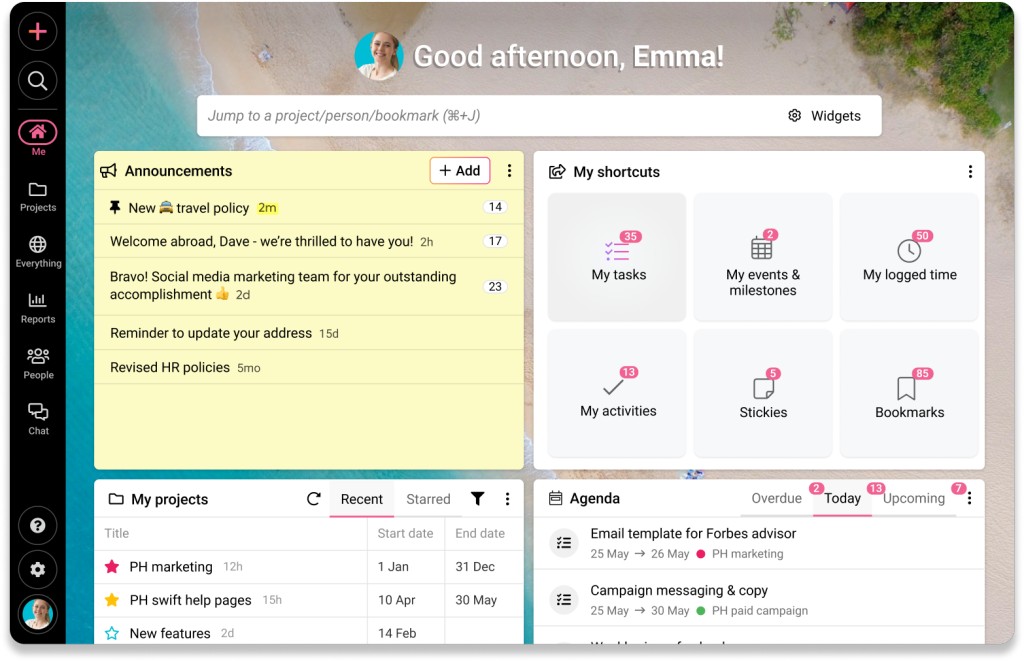
ProofHub is an easy-to-use project management and team collaboration software that simplifies project workflows and reduces complexity in dynamic processes. It offers a user-friendly interface that is easy to set up and use, making it a great choice for teams that want to avoid the complexity of Freedcamp while still needing project management capabilities.
While Freedcamp is more suitable for small organizations, ProofHub caters to the needs of small, medium, and large enterprises alike. It offers a scalable platform with powerful project management and team collaboration features, all within a single, easy-to-use interface.
In addition to that, ProofHub comes with the most significant advantage of pricing. Freedcamp charges you per user, free, whereas ProofHub comes with flat pricing. It means there is no need to pay per user. Unlimited users can use the tools for one flat fee.
In comparison to Freedcamp, ProofHub has advanced collaboration features such as built-in chat, discussions, notes, and file sharing, keeping your team on the same page without switching apps.
These shorter learning curve, collaboration features, flat pricing, and project management capabilities make ProofHub the best alternative to Freedcamp.
Key features
- File management: Keep all your project files in one place with version history, so you don’t need separate storage tools.
- Proofing: Review and give feedback on designs, documents, and files with comments and markups, avoiding long email chains.
- Project reporting: Get quick insights into project progress and team performance without doing manual reports.
- Time tracking: Track hours spent on tasks and projects to plan better and use resources wisely.
- Custom roles: Control what each team member can see and do by setting the right access levels.
- Built-in chat: Talk to your team directly within the platform and keep all discussions linked to your projects.
- Custom workflows: Set up task stages and approval steps that match your team’s way of working, keeping processes clear and consistent.
Pros
- Combines project management and team collaboration in one place
- Built-in chat helps in quick and easy communication among team members
- Intuitive and user-friendly interface
- Quick onboarding and simple learning curve
- Mobile app available for both iOS and Android smartphones
- An affordable and flat fee for unlimited users
- Effective and quick response from the customer support team
Cons
- Not suitable for individual use
- No free version is available; however, people can sign up for the 14-day free trial.
Pricing
ProofHub offers a straightforward flat pricing model with no per-user fee.
- 14-Day free trial
- Essential: $45/month billed annually for unlimited users
- Ultimate Control: $89/month billed annually for unlimited users
User ratings
- G2: 4.6/5
- Capterra: 4.5/5
2. Trello: Simple kanban-based projects
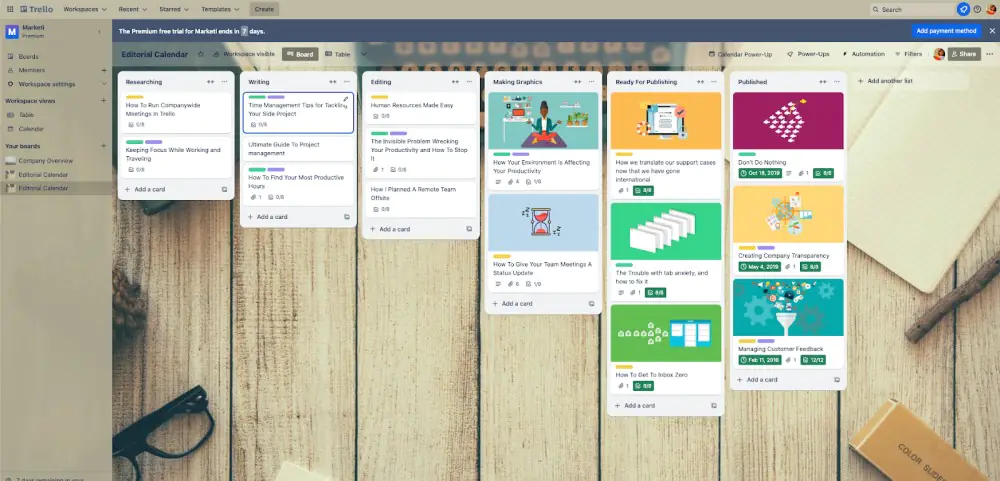
If you want a simple and visually appealing alternative to Freedcamp, Trello is a great option. It uses Kanban boards where tasks are displayed as cards,
You can set up separate boards for each project. On every board, tasks are added as cards and placed under columns that represent stages of work (like To Do, In Progress, Done). Each card can hold task details such as descriptions, assigned members, due dates, labels, checklists, and even file attachments, all in one place. This simple combination of boards, cards, and lists makes it easy for team members to understand and start using right away.
Fazarath F on G2 says, “The visual drag-and-drop interface is incredibly intuitive; it makes organizing tasks feel less like a chore and more like a game.”
Key features
- Card mirroring: With this feature, you can view and update cards across multiple boards simultaneously, reducing duplication of effort.
- Multiple views: Trello offers different views, including Board, Calendar, and Table views.
- Add-ons: Trello offers a comprehensive range of add-ons to improve the functionality of the platform.
- Customizable cards: Cards in Trello are highly customizable, allowing you to add attachments, labels, checklists, due dates, comments, and member assignments.
Pros
- Minimal learning curve with intuitive drag-and-drop interface
- Butler automation for task automation
- Add-ons for extending capabilities
Cons
- Limited reporting capabilities without add-ons
- It can become clunky when boards grow too large
Pricing
- Free: $0 (10 boards, unlimited cards, 10MB file limit)
- Standard: $5/user/month (250MB file limit, unlimited boards)
- Premium & enterprise: $10/user/month
User ratings
- G2: 4.4/5
- Capterra: 4.5/5
Read more: Trello alternatives: Project management tools for growing teams
3. Asana: Best for diverse integrations
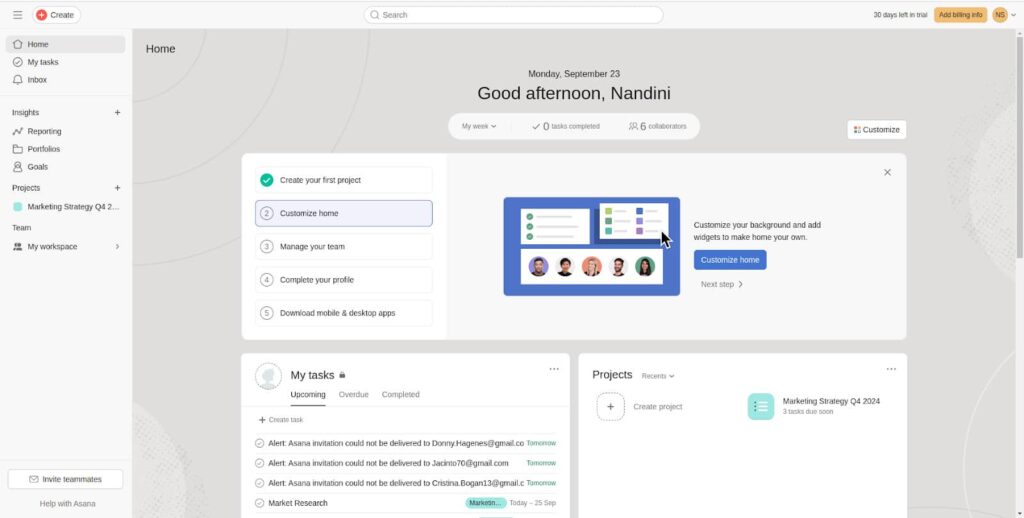
If you think Freedcamp’s integrations are limited and not meeting your needs, Asana is a strong alternative. It connects with 200+ popular apps like Google Drive, OneDrive, Microsoft Teams, Slack, and many more. This makes it easy to bring all your tools together and keep work flowing without constant switching.
Carrie W. on G2 wrote “We are at the very beginning of discovering integrations with Asana. The apps that we have integrated have been easy to setup.”
Key features
- Seamless task and workflow management: Organize tasks, manage workflows, and collaborate with your team in one place.
- Intuitive interface: Easy-to-use design that helps teams get started quickly.
- Save time with automation: Cut down repetitive work by automating recurring tasks.
- Real-time project reports: Get instant insights into progress and performance as work happens.
Pros
- 200+ integrations available
- Free plan with basic task management functionality for up to 15 users
- A bigger community of users
Cons
- Essential features are available in top-tiered plans only
- Can’t assign a single task to multiple assignees
Pricing
Asana offers five pricing options, including a free one
- Personal: Free
- Starter: $10.99/user per month/billed annually
- Advanced: $24.99/user per month/billed annually
- Enterprise: Contact the sales team for further details
- Enterprise+: Contact the sales team for further details
User ratings
- G2: 4.4/5
- Capterra: 4.5/5
Also read: 15 best Asana alternatives for teams
4. Wrike: Enterprise-grade project management
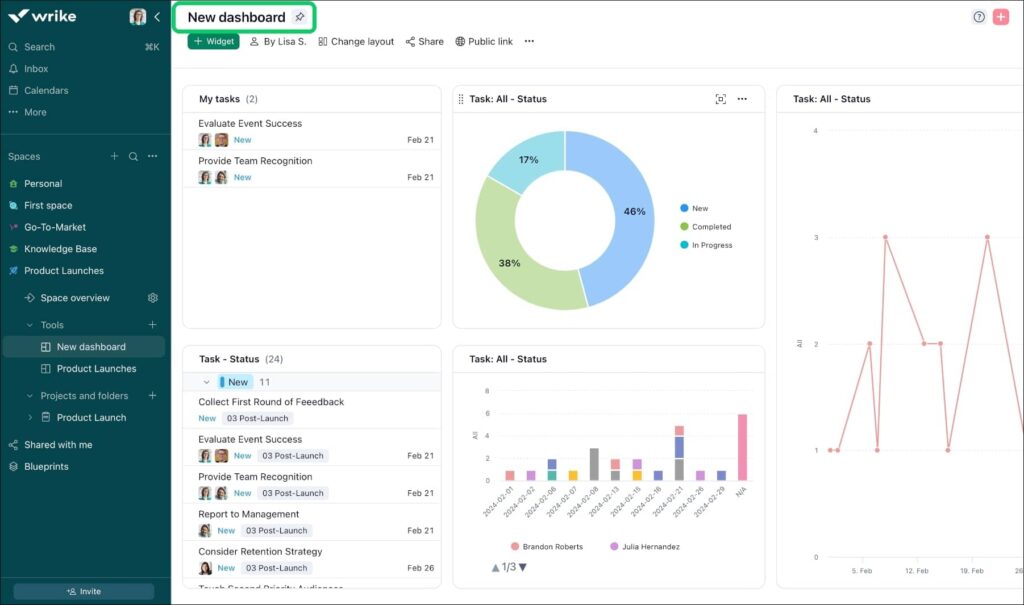
If you’re looking for an alternative that is built for large teams and complex projects, Wrike is a strong choice. It comes with a wide range of enterprise-grade features that make managing projects easier.
You will get features like project portfolio management, AI-powered automation, advanced reporting, and customizable workflows that give organizations the control and visibility they need.
Those advanced features also come with strong security and scalability, making Wrike a good fit for handling complex projects without losing efficiency or alignment. However, for small teams, Wrike can feel a bit overwhelming, and even small or mid-sized organizations may not need such heavy or complex features.
Key features
- Streamline secure administration and permissions: Set up security, access, and user permissions based on your team’s roles, processes, and organizational needs.
- Automate recurring workflows: Wrike’s automation engine syncs tasks in the background, cutting errors and manual updates across projects.
- Multiple project views: Switch between Kanban, Gantt, and other views to manage work your way.
- Real-time collaboration: Communicate with your team using @mentions and comments.
- Feedback and collaboration: Share updates and give feedback directly on projects.
- Reporting: Get clear insights on project progress, team performance, and resource usage.
Pros
- Form builder to create interactive forms with logic that changes based on answers.
- Three-pane view to see everything at a glance and get a quick overview.
- Custom dashboards to view all important information across teams and departments.
Cons
- It can be complex to set up and manage for smaller teams
- Expensive premium plans make it less suitable for startups and small teams.
- Does not offer an in-built live chat.
Pricing
- Free to get started with limited features
- The team plan for growing the team costs $9.80 per user/month (for up to 25 members)
- Business plan costs $24.80 per user/month (for up to 200 users)
- For Enterprise and Pinnacle plans, you have to contact their sales team
User ratings
- G2: 4.2/5
- Capterra: 4.4/5
Read more: The 21 Best Wrike alternatives to try for project management
5. Monday.com: Visually appealing workflows
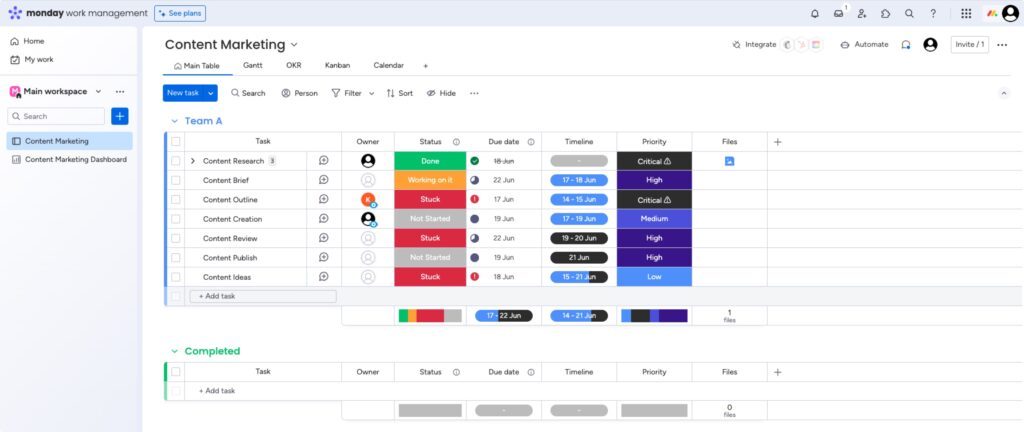
Compared to Freedcamp, Monday looks visually pleasing. When you first set it up, it offers a colorful grid called “boards,” where you put the task list. You can customize these boards with different views like Kanban, timeline, calendar, or Gantt charts to match how your team prefers to work. Monday.com also offers powerful automation to reduce repetitive tasks, saving time and effort.
While it’s easy to use and visually attractive, the cost can become high for larger teams. Some advanced features may require you to upgrade to higher-priced plans. Still, for teams that value flexibility, design, and strong collaboration, monday.com is a good choice.
Key features
- Color-coded statuses and priorities: Quickly see which tasks are on track, urgent, or pending, helping your team stay organized at a glance.
- Flexible views: Switch easily between table, Kanban, Gantt, calendar, or timeline views so your team can work in the way that suits them best.
- Forms: Collect structured information from team members or external stakeholders, with all responses feeding directly into your boards for easy management.
Pros
- Seamless integration with a variety of tools.
- Real-time engine for team collaboration.
- Dashboards for visual project tracking.
Cons
- Certain features are limited to paid plans.
- Not recommended for solopreneurs or freelancers.
- Lack of flexibility.
Pricing
- Free to get started for up to 2 members
- The Basic plan costs $9 per seat/month when billed annually
- The Standard plan costs $12 per seat/month when billed annually
- The Pro plan costs $19 per seat/month when billed annually
User ratings
- G2: 4.7/5
- Capterra: 4.6/5
6. Basecamp: Simple and straightforward collaboration
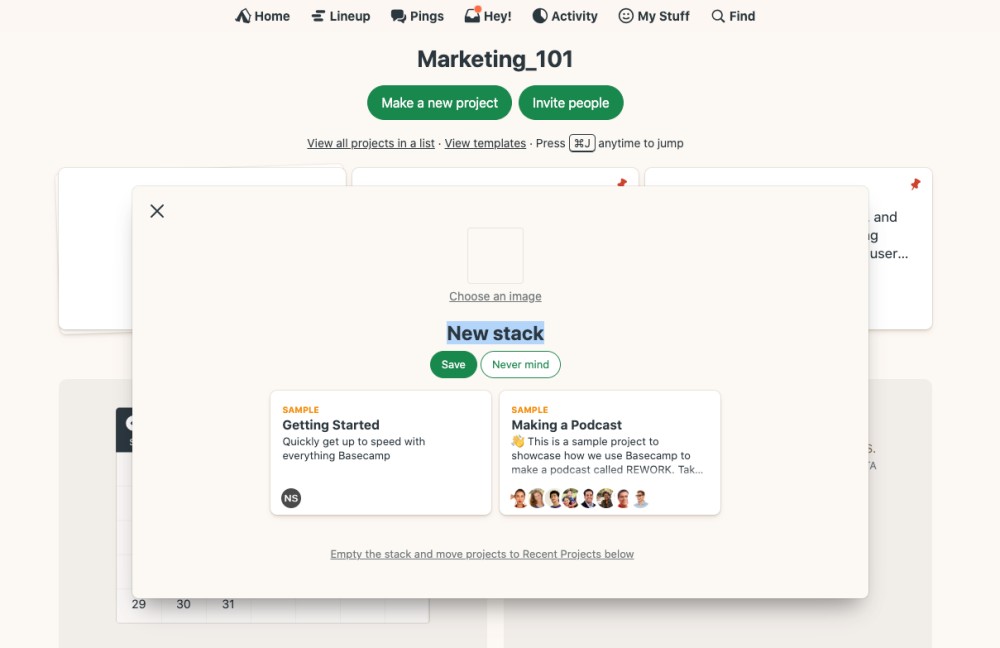
If Freedcamp’s collaboration feels limited, Basecamp is a great alternative. It brings communication, task management, file sharing, and project organization together in one simple platform.
The biggest advantage of Basecamp is its simplicity. Teams can easily stay on the same page, share updates, and collaborate without getting lost in complex features. Everyone knows what’s happening, what’s coming next, and what decisions have been made, all without chasing updates across multiple tools.
Key features
- Shared calendars: Keep everyone on the same page by sharing events, deadlines, and milestones so your team never misses important dates.
- Document and file management: Upload and organize documents, images, and files within each project to keep everything in context and avoid scattered information.
- Real-time chat: Communicate instantly with teammates for quick updates, informal discussions, or spontaneous feedback without leaving the platform.
- Visual project tracking: See what’s completed and what’s still pending, giving a clear view of progress and helping teams stay on top of momentum.
Pros
- To-do lists for task tracking and assignment
- Neat, intuitive, and user-friendly interface with navigation.
- Message Boards for centralized communication and file sharing
Cons
- No multiple project views
- Doesn’t allow you to add a tag or label to tasks
- Limited project analytics and customization in project reporting
Pricing
Basecamp offers three pricing options:
- Basecamp free
- Basecamp plus: $15/user/month (billed annually)
- Basecamp Pro Unlimited: $299/month (billed annually)
User ratings
- Capterra: 4.6/ 5
- G2: 4.7/ 5
7. ClickUp: Feature-rich project management solution
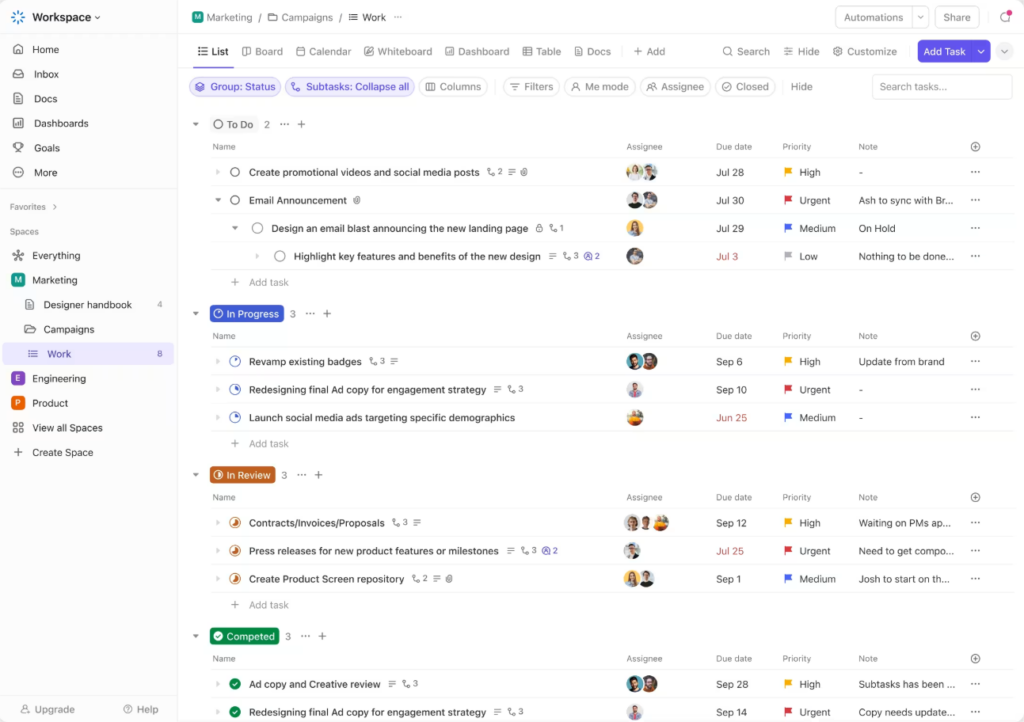
ClickUp is a feature-rich project management software that offers task management, file sharing, and communication tools. It is vividly known for its multiple views, customization, and reporting capabilities.
Plus, the workflow management goes well beyond basic customization. You can create automation rules and set up relations between multiple workspaces as per your preferences.
While ClickUp offers robust functionality for project management, it’s worth noting that the user interface of ClickUp might initially appear overwhelming or confusing, requiring a learning curve to fully master all its features.
Key features
- Multiple views: Over 15 views, like Gantt charts, mind maps, and whiteboards for flexible planning.
- Customization: Adjust almost everything to fit your team’s needs.
- Chat: Real-time messaging within the platform, though you need to set up spaces for private chats.
Pros
- More customizable than Freedcamp
- Advanced features like mind maps and formula columns.
- Native time tracking
Cons
- Steeper learning curve than Freedcamp
- Less intuitive interface, making complexity hard to handle
Pricing
- Unlimited: Starting at $7/user/month
- Business: Starting at $10/user/month
- Enterprise: Custom pricing
User ratings
- G2: 4.7/5
- Capterra: 4.6/5
Also read: 16 Best ClickUp alternatives & competitors
What are the key features to look for in a Freedcamp alternative?
Every organization has its own needs, and there are a number of project management tools available in the market, so finding the best fit for your teams has become increasingly difficult. To solve these issues, I have compiled a list of essential features to consider when searching for Freedcamp alternatives for project management:
- Ease of use: The tool should be simple enough that your team can start using it without any need for formal, time-consuming training. A clean, well-organized interface and easy navigation save time and reduce frustration.
- Real-time communication: The selected tool must contain a built-in chat or instant messaging to keep discussions in one place so you can reduce the need for extra tools.
- Reviewing and approval tools: To keep projects moving smoothly, it’s important to have built-in features for reviewing and approving work. Look for tools that allow team members and managers to give feedback, make edits, and approve files within the platform.
- Strong reporting features: Look for alternatives that offer detailed reporting and analytics features to help you make data-driven decisions.
- Minimal learning curve: A project management tool should be easy to learn, even for beginners. The simpler the tool, the faster your team can adapt without spending weeks on training.
- Price and Scalability: Make sure the tool fits your budget now and can grow with your team. Compare pricing plans carefully and check how costs increase as your team or projects get bigger.
How to choose the best Freedcamp alternative for your team?
Choosing the right Freedcamp alternative isn’t just about switching tools; it’s about finding a solution that fits your way of working. The right tool will make daily collaboration easier, improve productivity, and support your team as it grows. Here are some points to consider while choosing an alternative to Freedcamp
1. Assess your team’s size
The first thing you should consider while choosing Feedcamp alternatives is your team size. Smaller teams often prefer tools like Trello or Basecamp, where learning curves are minimal. Larger teams may need platforms like ProofHub to help them scale cost-effectively.
2. Pinpoint your biggest challenge
Be clear about what’s making you switch. If you’re frustrated by complexity, tools like Trello offer simplicity and faster onboarding. If your main issue is limited features, platforms like Wrike, ProofHub, or monday.com provide advanced workflows, automation, and scalability.
3. Match features to your workflow
Choose a platform that supports the way your team already works. For example, if your team relies on visual task tracking, pick a tool with a strong Kanban board. If approvals and file reviews are part of your daily process, look for built-in review and feedback options like ProofHub.
4. Look beyond the subscription price
Consider setup, training, and integration costs. Check how pricing scales as your team grows. ProofHub’s flat-rate model can be more cost-effective long-term, while tools with strict per-user pricing can quickly get expensive as your team grows.
5. Think about future growth
Choose a tool that can grow with your team. The best platforms offer features that scale, so you don’t have to switch every time your team expands or projects get more complex. Think ahead for the next two to three years instead of just solving today’s problems.
Conclusion
Freedcamp is a good project management tool that offers a range of basic features at an affordable price. But as teams grow or projects become more complex, users start looking for something better. You may need advanced features like stronger collaboration tools, better reporting, and automation.
From Trello to ClickUp, each tool has its own strengths: Trello with its visual boards, and ClickUp with its all-in-one workspace.
Still, I can firmly say that ProofHub stands out as the best choice as it combines project management and team collaboration in one place. Features like Gantt charts, task boards, and custom permissions make it easy to plan, track, and manage work effectively. And with its simple flat-fee pricing for unlimited users, it’s a practical choice for growing teams who value both agility and accountability.
Frequently asked questions
Which Freedcamp alternatives offer better task management features?
ProofHub is one of the top task management software widely chosen by teams of all sizes. It lets you create and assign tasks to individuals or groups, ensuring the right person handles the right job. You can set deadlines, add labels or priorities, and break work into subtasks for better clarity. Teams can also track progress using task lists, Kanban boards, or Gantt charts, making it easy to stay on top of every stage of the project.
Which tools offer better value than Freedcamp for small teams?
ProofHub offers great value to small teams by combining project management and team collaboration in one platform. It includes task management, discussions, file sharing, time tracking, and reporting in a single workspace. Teams don’t need to juggle multiple tools. Moreover, with its flat-fee pricing, small teams don’t have to worry about per-user charges as they grow.

